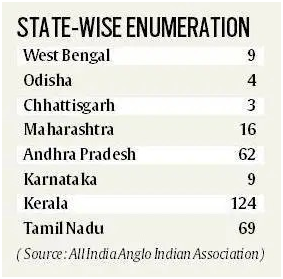

Recently, Parliament passed the Constitution (126th Amendment) Bill, extending reservation for SC/STs but doing away with the provision for nomination of Anglo Indians to Lok Sabha and some state Assemblies.
Context
Recently, Parliament passed the Constitution (126th Amendment) Bill, extending reservation for SC/STs but doing away with the provision for nomination of Anglo Indians to Lok Sabha and some state Assemblies.
About
- Article 331 of the Constitution Provides for nomination of two Anglo-Indians to Lok Sabha. It says: “Notwithstanding anything in Article 81, the President may, if he is of opinion that the Anglo-Indian community is not adequately represented in the House of the people, nominate not more than two members of that community to the House of the People.” The 126th Amendment does away with this.
- The idea of such nominations is traced to Frank Anthony, who headed the All India Anglo-Indian Association. Article 331 was added in the Constitution following his suggestion to Jawaharlal Nehru.
- Article 333 deals with representation of the Anglo-Indian community in Legislative Assemblies. It says: “Notwithstanding anything in Article 170, the Governor of a State may, if he is of opinion that the Anglo-Indian community needs representation in the Legislative Assembly of the State and is not adequately represented therein, [nominate one member of that community to the Assembly].”
- Currently 14 Assemblies have one Anglo-Indian member each: Andhra Pradesh, Bihar, Chhattisgarh, Gujarat, Jharkhand, Karnataka, Kerala, Madhya Pradesh, Maharashtra, Tamil Nadu, Telangana, Uttar Pradesh, Uttarakhand and West Bengal. The 126th Amendment does away with this as well.
- According to the 10th Schedule of the Constitution, Anglo-Indian members of Lok Sabha and state Assemblies can take the membership of any party within six months of their nomination. But, once they do so, they are bound by their party whip. The Anglo-Indian members enjoy the same powers as others, but they can not vote in the Presidential election because they are nominated by the President.
Who are Anglo-Indians?
- The Anglo-Indian community in India traces its origins to an official policy of the British East India Company to encourage marriages of its officers with local women.
- The term Anglo-Indian first appeared in the Government of India Act, 1935.
- In the present context, Article 366(2) of the Constitution Of India states: “An Anglo-Indian means a person whose father or any of whose other male progenitors in the male line is or was of European descent but who is domiciled within the territory of India and is or was born within such territory of parents habitually resident therein and not established there for temporary purposes only…”

- According to 2011 Census there are only 296 people who identified themselves as belonging to the sect Anglo Indian. However, All India Anglo Indian Association contested the data and asserts that there are many more Anglo-Indians in the country.
Who are the Anglo-Indians nominated to Lok Sabha over the years?
- Henry Gidney made it to the Central Legislative Assembly under the Special Interests/Anglo-Indian category in the 1920, 1923, 1926, 1930, and 1934 elections.
- Frank Anthony got nominated to Lok Sabha in 1952, 1957, 1962, 1967, 1971, 1980, 1984 and 1991. A E T Barrow came close to him with seven tenures — in 1951-1952, 1957, 1962, 1967, 1977, 1980, 1984. Marjorie Godfrey was nominated in 1971. In 1977, Rudolph Rodrigues replaced Anthony.
- Joss Fernandez and Paul Mantosh were nominated by the Janata Dal government headed by V P Singh in 1989.
- The Congress government led by P V Narasimha Rao nominated Robert E Williams in 1991. Sheila F Irani had a brief stint from 1995 to 1996. Neil O’Brien and Hedwig Rego also had brief tenures of two years, from 1996 to 1998. Beatrix D’Souza and Neville Foley, both of the Samata Party, led by George Fernandes, were nominated in 1998. D’Soura continued in 1999 too, but Foley was dropped to make way for Denzil B Atkinson of the BJP.
- When the Congress-led UPA came to power, Ingrid McLeod got the nomination twice, in 2004 and 2009. Francis Fanthome came in to the Lok Sabha in 2004 and Charles Dias, a civil servant, in 2009. The BJP-led government of Narendra Modi brought in George Baker, an actor, and Richard Hay, a teacher from Kerala, in 2014.
- In 2014 the NDA government nominated George Baker, an actor, and Richard Hay, a teacher from Kerala. In the current Lok Sabha the two seats still empty.
Conclusion
The All India Anglo-Indian Association has contested the population figures given by 2011 census. 296 number is very low and how come there can be nominated members in Assemblies when the census shows no Anglo-Indians in those states. There is urgent need to relook into the issue and find out the actual population of the community. There was no need to end the nomination to the Lok Sabha and the state Assemblies of Anglo Indians if they were not fairly represented.

